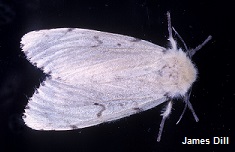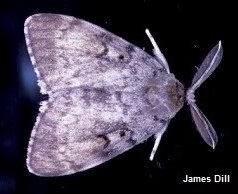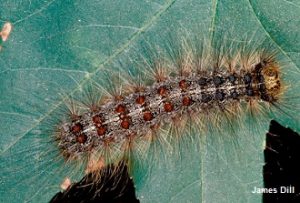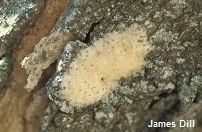Spongy Moth (Lymantria Dispar)
Pest Management Fact Sheet #5024
James F. Dill, Pest Management Specialist
Clay A. Kirby, Insect Diagnostician
Charles D. Armstrong, Cranberry Professional & Staff Entomologist
For information about UMaine Extension programs and resources, visit extension.umaine.edu.
Find more of our publications and books at extension.umaine.edu/publications/.
Description & Biology
Spongy moth (Lymantria dispar) caterpillars feed on most hardwood trees, except ash. They prefer oak, poplar, gray birch and fruit trees. When half grown or larger, the larvae are also likely to feed on evergreens. As the number of Spongy moth larvae in an area increases, their favorite food sources start to become depleted. The larvae are then likely to feed on a variety of ornamental trees and shrubs.
Healthy hardwoods can usually withstand two to three years of defoliation. However, secondary attack by insects or diseases can shorten or affect the life of weakened trees. Weakened, diseased, insect-damaged or shaded trees, particularly those already struggling with poor soil or moisture conditions, are especially vulnerable. Severely defoliated evergreens are less likely to survive than are other kinds of trees.
- Lymantria dispar Female
- Lymantria dispar Male
- Lymantria dispar Caterpillar
- Lymantria dispar Egg Mass
Spongy moth infestations have historically been heaviest in central and southern Maine, but recently their numbers have been very heavy in western Maine as well. In addition to defoliating trees, they are also nuisance pests because of wandering caterpillars, droppings, pupal cases and egg masses on homes and the spinning/ballooning down of young caterpillars. Tiny hairs from the caterpillars can irritate the skin of some people. In some cases, severe reactions result in rashes and/or itching, not unlike the reactions to the hairs of the dreaded browntail moth caterpillars, another tree pest in the same family of moths (family Erebidae). If consulted, a doctor should be informed of the possibility of contact with caterpillar hairs from the Erebidae family.
Overwintering Spongy moth eggs hatch in May. The young, 1/16-inch, hairy, black caterpillars have a small knob on each side of the head and are first seen near clusters of eggs. It takes up to a month for all of the eggs to hatch. For this reason, it is common to find caterpillars of various sizes coexisting together at any given time. The larvae soon crawl into treetops, where they spin down on lines of silk to be blown to new places.
Feeding by the young caterpillars on the underside of leaves usually goes unnoticed. By the time they are half grown, ¾ to 1 inch long, entire leaves are often eaten. At this stage, the caterpillars are mostly black, except for orange markings down their backs. Careful selection and use of insecticides and biological controls at this time can provide effective control of wind-blown caterpillars.
The caterpillars molt five or six times before pupation. When the caterpillars are 1 inch or more in length, their feeding is more noticeable. At night and/or on cool days, they move up into the trees to feed. During hot, dry and sunny days, they move down to rest on lower branches, trunks or on lawns.
The late stage caterpillars are hairy, dark and easily distinguished by five pairs of blue spots on the front body segments and six pairs of red spots on the back body segments. Fully grown larvae are 1 ½ to 2 ½ inches long. About 70 percent of their food is consumed during this stage of their development. The mature caterpillars are able to strip a tree overnight.
In July, the mature larvae seek protected places of almost any kind to form their reddish brown pupae. Male pupae are about ¾ inch long and female pupae are about 1 inch long. Ten to 15 days following pupation, the moths emerge.
Male spongy moths are excellent flyers. They are usually dark brown. Their front wings display black, wavy bands and V-shaped markings while their hind wings are light brown but trimmed with dark brown. Their wingspan is about 1½ inches. The male moths have conspicuous, feather-like antennae.
Female spongy moths are larger than males and predominantly white with a few faint, wavy brown or black bands and V-shaped markings on the front wings. Marginal dark spots are found on both the front and hind wings. They have a wingspan of 2 to 2½ inches yet they cannot fly.
Because they cannot fly, female spongy moths do not move far from their own pupation site in order to lay their 500 or more eggs. The eggs are covered with a tan, velvet-like mass constructed from the female moth’s hairs. Spongy moth overwinters in the egg stage. Moths die soon after mating and egg-laying. There is only one generation of Spongy moth per year.
Several factors can affect Spongy moth populations: weather, predators, parasites and diseases. One night of -20°F or colder kills many of the overwintering eggs if they’re not covered with snow.
Management
Mechanical
Eggs can be crushed, but it is difficult to crush all of the eggs in an egg mass that happens to be on bark or on a similarly rough surface. Eggs can also be scraped away or otherwise removed and destroyed. They must not be allowed to fall to the ground, where protective snow cover will increase their chance of survival and subsequent hatching.
Burlap can be wrapped around the trunks of trees to collect caterpillars and prevent them from climbing onto branches to feed. Collected caterpillars can then be killed. Crushing any female moths, caterpillars, pupae or eggs helps protect ornamental trees, but only if a high percentage of the population is killed.
Barriers
Commercially available sticky petroleum materials are available to keep caterpillars from getting into the canopy of trees. Tin, plastic, etc., can be placed around the tree trunk to accomplish the same purpose. Some people put petroleum jelly, oil or grease on the wrappings for additional protection, but greasy substances must be kept off the trees themselves and removed when the caterpillars are gone. Most petroleum products, sticky products, oil, grease or diesel fuel should not be put directly onto trees, because they will penetrate into the bark. This is especially true of younger trees. Trees four inches in diameter have been killed in only one season when grease was applied to their bark. If grease does get on the bark, scrape it off as soon as possible and keep it off the ground to avoid contaminating the tree’s root zone. Barriers are most effective when: the tree is isolated, only a few caterpillars are in the tree when the barrier is applied, or an insecticide was recently applied.
Insecticides
Insecticides such as Bt (Bacillus thuringiensis; for young larvae), neem, spinosad, carbaryl (Sevin®), cyfluthrin, orthene, and malathion can be used to control caterpillars. Spray anytime caterpillars are present, but for optimal results, spray before they are half grown at ¾ to 1 inch long. Foliage should be sprayed in late afternoon or early evening for best results and for the greatest protection of bees, predators and parasites.
When Using Pesticides
ALWAYS FOLLOW LABEL DIRECTIONS!
Pest Management Unit
Cooperative Extension Diagnostic and Research Laboratory
17 Godfrey Drive, Orono, ME 04473
1.800.287.0279 (in Maine)
Information in this publication is provided purely for educational purposes. No responsibility is assumed for any problems associated with the use of products or services mentioned. No endorsement of products or companies is intended, nor is criticism of unnamed products or companies implied.
© 2016, 2018 | Reviewed and Revised: 2022, 2023
Call 800.287.0274 (in Maine), or 207.581.3188, for information on publications and program offerings from University of Maine Cooperative Extension, or visit extension.umaine.edu.
In complying with the letter and spirit of applicable laws and pursuing its own goals of diversity, the University of Maine System does not discriminate on the grounds of race, color, religion, sex, sexual orientation, transgender status, gender, gender identity or expression, ethnicity, national origin, citizenship status, familial status, ancestry, age, disability physical or mental, genetic information, or veterans or military status in employment, education, and all other programs and activities. The University provides reasonable accommodations to qualified individuals with disabilities upon request. The following person has been designated to handle inquiries regarding non-discrimination policies: Director of Equal Opportunity, 101 Boudreau Hall, University of Maine, Orono, ME 04469-5754, 207.581.1226, TTY 711 (Maine Relay System).





